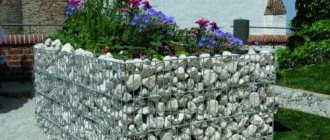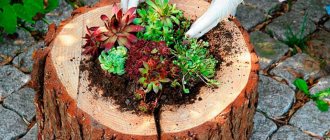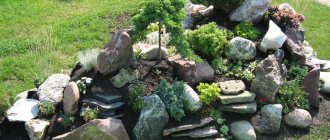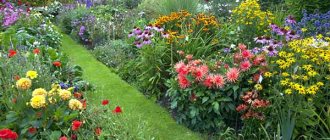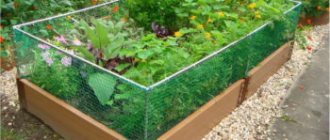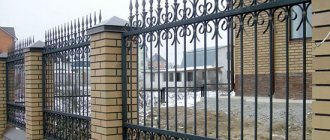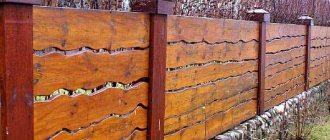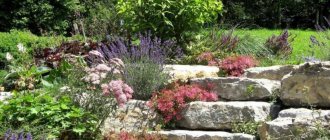Almost all owners of private houses and summer cottages strive to improve their plots, making them not only practical, but also beautiful. To do this, lawns are laid, shrubs are planted, and flower beds are arranged. Original and elegant borders for flower beds allow you to give the area a neat and finished look. Many people invite specialists to plan their yard design, but you can do it yourself. To do this, you should familiarize yourself with the features of materials for the manufacture of fences and options for their use.
Features of borders for flower beds
In a competent yard design, every little detail matters from both a practical and aesthetic point of view. This also applies to flower beds, where not only the color of the plants is important, but also their external frame.
A correctly selected and manufactured border for a flower bed performs the following functions:
- Decoration. The tastefully made structure emphasizes the sophistication of the plantings, while at the same time harmoniously fitting in and complementing the design of the site.
- Limiting growth. Miniature fences are dug to a sufficient depth to prevent flower roots from penetrating beyond its boundaries.
- Retention of fertile soil. Attractive garden borders prevent soil from falling onto your path or lawn when it softens during rain.
- Protection from external factors. The fence prevents children and pets from entering the lawn and damaging the plantings.
- Division by zones. When planting several varieties of flowers, intermediate fences separate them into compartments, which facilitates subsequent care.
In addition, homemade fences are a manifestation of the creative side of the property owner’s personality and level of skill.
Application of a decorative border
Creating flower beds, flower beds and other decorative elements is a favorite activity of landscape decor specialists and most summer residents. Using border tapes, they fix the soil in the desired configuration and create flower beds consisting of several levels that look like a real designer masterpiece. Flower beds created using border strips look not only beautiful in the garden, but also neat.
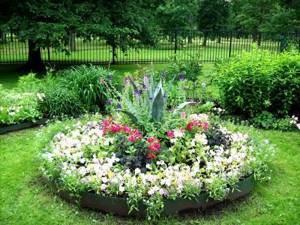
Decorating flower beds with border tape, photo
Let's look at an example of how to use a border strip to turn an ordinary flower bed into a multi-level landscape composition and how to dig in the border strip correctly. To bring this idea to life, you will need pruning shears, garden shears, and a soldering iron (this tool is needed for soldering sections).
So, let's get to work:
- Prepare a compact ditch for installation; when forming the depth of the trench, be guided by the width of the tape.
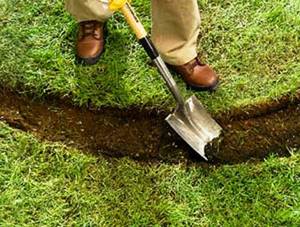
Place the strip in a vertical position so that the edge protrudes 3 cm above the soil. Stretch the ribbon with your hands and use pegs to shape it.
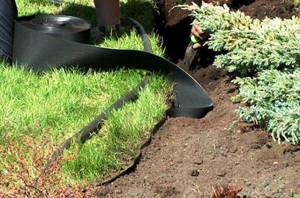

To make it easier for you to understand how to apply a border strip and secure the tape, study the video material on this topic:
You can purchase border material at any store that specializes in selling garden goods. The cost of this product is affordable, and you can easily find the size you need.
What types of borders are there, how to choose
When choosing borders for a flower bed, you should take into account criteria such as shape, size and material of manufacture. To keep costs to a minimum, you should use available materials, of which there are sufficient quantities in private households.
As for the forms, there are no restrictions except the design of the site. The configuration of the fences must correspond to the layout of the buildings located in the yard.
The best options are:
- square;
- rectangle;
- rhombus;
- oval;
- circle;
- polyhedron;
- triangle.
When planning flower beds, it is not necessary to stop at a two-dimensional projection. Fences can be arranged volumetrically, in angular or curved tiers.
The correct choice of the height of the structure also plays an equally important role. If there is no risk of damage to plants and on a flat area, it is enough to limit yourself to light and low structures up to 10 cm high, which serve as demarcation functions. When there is a risk of flowers being damaged by children and animals, the height increases to 40 cm. For bulk flower beds, the fences are raised to 30 cm and made blank to prevent soil from being washed out.
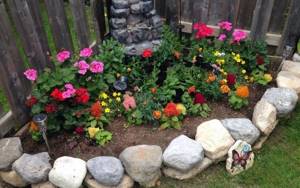
Types of borders for garden paths and flower beds according to materials for production
The choice of material for making a flowerbed border must be approached responsibly and thoughtfully.
The product must meet the following criteria:
- environmental Safety;
- strength;
- rot resistance;
- durability;
- presentable;
- possibility of repair and dismantling;
- applicability to terrain.
Before starting work, it is advisable to make several sketches of the fences and select the most suitable ones.
Wooden options
Making a border for a flower bed with your own hands is not difficult; household tools that are found in every home are suitable for this. At the same time, it is not necessary to buy new boards for installation. The remains of an old fence, frame for panels, shipping pallets from under bricks or paving slabs are suitable.
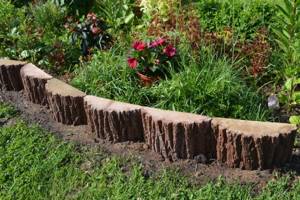
You can choose 1 of the following fencing design options:
- A picket fence, reminiscent of a standard structure made from boards.
- Log palisade. It is made from thin and well-dried tree trunks with the bark removed. For safety reasons, it is better to leave the top edge flat.
- Wicker border. The material is fresh willow vine. Weaving is done in sections or along the entire perimeter at once.
Before digging in a piece of wood, you need to treat it with an antiseptic, hydrophobic impregnation and varnish.
Stone structures
Stone structures are durable, biologically inert and have an almost unlimited service life.
For construction can be used:
- cobblestone;
- crushed stone of different fractions;
- gravel, pebbles;
- clastic rocks with jagged edges.
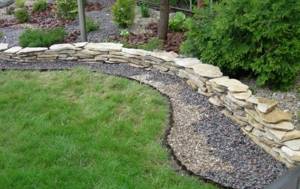
Laying is carried out dry or wet. In the first case, the stones are laid on the surface and perform a delimiting function. The wet method involves filling the cracks with cement mortar and then decorating.
Metal solutions
Metal borders for flowers are strong and durable. To make an elegant and beautiful fence, you can use old window grilles and forged stands for flowerpots. Using a welding machine, you can make a fence yourself - from reinforcement rods and sheet metal. A good solution for assembling a blind structure are scraps of corrugated sheets left over after installing the roof or gate. The blanks are cut out, after which they are given the desired shape.
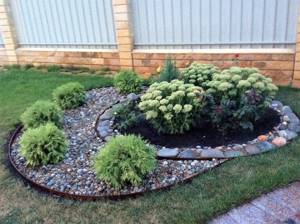
It must be remembered that all types of metal are prone to corrosion. To protect products from moisture and ultraviolet radiation, protective compounds should be used.
Plastic
Plastic borders for flower beds are a budget option for landscaping. In any household there are a lot of things that can be used as raw materials for construction. These could be old containers, dishes, furniture, interior decoration elements. The advantage of polymer fencing fragments is their strength and resistance to dampness and ease of installation. In this case, no preparatory measures need to be taken. All you need to do is dig or hammer the plastic into the ground.
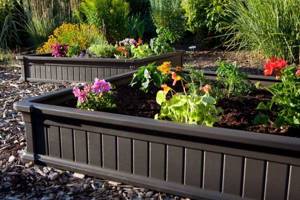
Sectional types of structures
This is a practical way to put plastic containers to good use. Every household has a lot of cell boxes that were used in the past for storing food and things. Containers are dug into the ground in a straight or staggered pattern, after which they are filled with fertile soil and seedlings.
Several problems are solved here:
- disposal of unnecessary items;
- fencing for soil and roots;
- decoration of the site;
- protection from external influences.
If the color of the boxes does not fit into the landscape, then they can be coated with moisture- and UV-resistant paint or decorated with colored ribbons.
Brick border
This material is one of the most popular in landscape design. A brick border for a flower garden fits organically into any design and looks great against the background of similar buildings. Only products made from baked clay are suitable for work, as they can easily withstand prolonged exposure to damp soil.
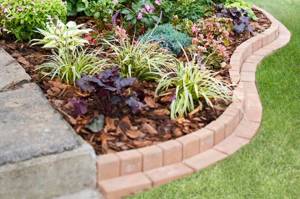
Laying can be done directly on the ground or in a ditch. The stones are installed horizontally, flat, at an angle. To make the structure more impressive, it is coated with lime or paint.
Alternative Framing Materials
To choose the optimal material for forming a site for seedlings or a flower bed, you need to evaluate the pros and cons of other materials.
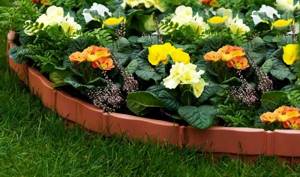
Border tape for flower beds: how to use, photo
To mark the boundaries of beds and paths on personal plots, the following types of fencing are used:
Let’s take a closer look at each of the above to understand why plastic curb products are better.
Slate frame
A few years ago, slate fencing for garden beds was extremely popular. This material was in demand due to its affordable price and the possibility of using leftover raw materials: for example, if there was slate left after the roof was installed.
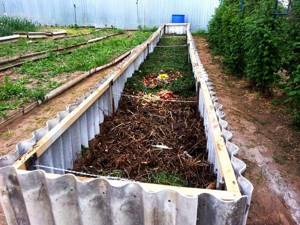
Many summer residents were forced to abandon slate frames for beds due to the inherent disadvantages of this material. The disadvantages of slate structures include fragility: slate is easily damaged during installation and use. In addition, this material is not environmentally friendly; after some time after installation, it begins to release toxic substances into the soil, which negatively affect flowers and other plants.
Wooden structures
Fences for flower beds made of wood are environmentally friendly; they can be used to create structures of various heights, but over time, wooden products begin to rot and collapse under the influence of damp soil.
Garden beds framed with wooden fences look nice, but such fences are short-lived.
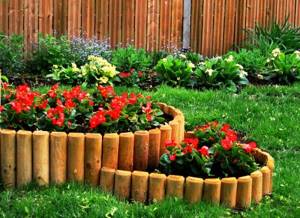
To prevent swelling and rotting of wooden borders, they are treated with protective agents, applied in several layers, and varnished. This design is suitable for most garden areas, but is more expensive than plastic borders.
Metal frames
To create beds of the desired shape and fix the soil under the flower beds, galvanized metal sheets are used.
Metal fencing is susceptible to corrosion, and to protect these curbs, they must be painted or varnished every year.
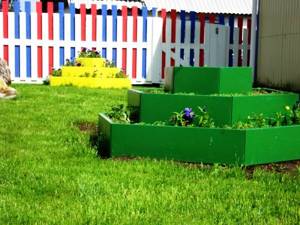
Metal fences look aesthetically pleasing and are durable, but they are not cheap.
Fencing made of concrete or stones
This material is rarely found on a regular garden plot. It is used by landscape design specialists. Stone fences look presentable and last a long time, but they are expensive, like concrete structures.
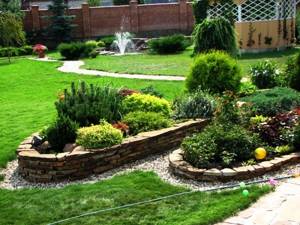
Such decorations look especially impressive on large suburban areas.
In addition to the high price, the disadvantage is the large size of the stone and concrete fencing elements. Such structures are unlikely to fit on a small summer cottage.
Plastic borders are the best solution
Plastic border strips are the best solution for decorating vegetable beds and flower beds. Their purchase will be inexpensive, and the desired height is easy to select. Such products are easy to install, and even a multi-level bed can be created with their help in a few hours.
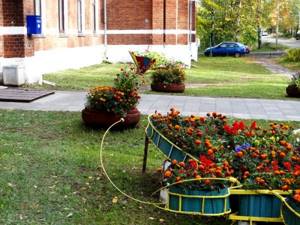
Long service life and resistance to damage are a big advantage in small areas. The material's resistance to rot and moss allows the soil to dry out faster and allow better air flow.
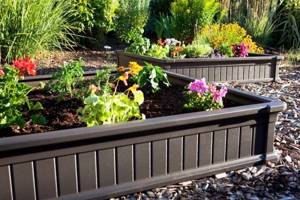
There are many options for using border tape. A variety of colors and different methods of use have made this material quite popular and in demand among summer residents.
Original methods of fencing from scrap materials
In most cases, to make decorative fences and borders for flower beds with your own hands, there are enough items that you have in the barn and pantry. The use of available materials allows you to achieve good savings and high quality of the final result.
Slate
Finding the right amount of material for the job is not difficult, since slate is found in almost every yard. The main problem with used sheets is that after 15 years of service they begin to release asbestos dust into the air. Therefore, before starting work, the slabs must be treated with deep penetration impregnation, and during cutting they must be continuously moistened.
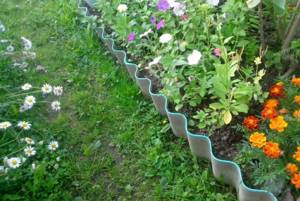
Slate is strong enough to withstand vertical impacts when driven into the ground. The upper edge of the fence can be smooth, angular or wavy, depending on the wishes of the owner and his skill in using an angle grinder. Few people are happy with the gray color, so the fence fragments are painted before installation.
Glass and plastic bottles
A garden bed border made from used bottles is a great way to both get rid of trash and create a unique border for your flower bed. Containers made of plastic and glass are suitable, but the second option is less preferable, since such material can easily be broken, and its fragments can injure your hands. Therefore, it is advisable to focus on PET products, which are completely safe.

For work, it is better to take bottles of the same size, and better yet, the same color. The containers need to be filled with sand or granite screenings, the backfill compacted and the lids screwed on. After this, a ditch is torn off and bottles are inserted into it, neck down. The advantage of this design is that it is free, and it is not difficult to repair and dismantle it.
Tires
Decorative borders for flower beds made from old tires are not a new invention; such structures can be seen on many private plots and in the courtyards of apartment buildings. As with plastic bottles, there is no need to spend money on purchasing fencing blanks. You can collect the required number of tires along the roads or go to a service station, where they will be happy to give them away for free. All that remains is to deliver the wheels to the installation site. It is not necessary to look for tires of the same size.
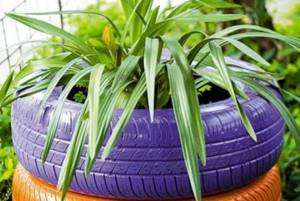
Tires are installed end-to-end, staggered, staggered and in tiers. The choice is limited only by the imagination of the designers. You should think about the issue of rubber decor in advance. Black curbs will not decorate the area, and when heated, the tires emit a pungent odor. You can immediately get rid of 2 problems by painting the wheels with acrylic paint.
Ceramic products
Ceramics fits organically into the design of any yard where there is a lawn, buildings made of brick and wood. You can use both whole dishes and their fragments to create a flower fence.
In the first case, old clay pots or plates are used, or you can combine them. The fragments are simply carefully dug into the ground to a depth sufficient for stability. Such structures require increased attention when caring for flowers.

The second option involves pouring a thin concrete strip. After the solution has hardened, the formwork is removed and the concrete base is decorated. The materials used are fragments of colored glass, ceramic tiles, pebbles, small stones, and beads.
What fencing options are there?
Even before you plant a flower garden, you should think about how to make a beautiful border for your flower bed. It should not only serve as the border of the flower structure, but also correspond to the general style of the surrounding area.
Border mosaic looks elegant and noble, and has one attractive quality - it is unique. Using glass and tile shards, you can create a unique, original design or ornament, and you can be sure that you will not find another flower bed frame like this. Instead of fragments, you can use regular or painted pebbles.
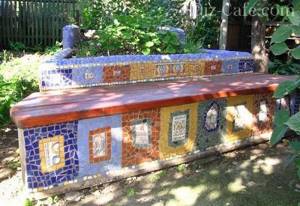
The flowerbed itself and the base of the bench are decorated with multi-colored mosaics. For the work we used pieces of ceramic facing tiles - a few pieces always remain after repairs
When creating a Mediterranean or English style in your garden, you can opt for fences made of natural stone: granite, shell rock, limestone, sandstone. They are equally good for decorating free-standing plants and for decorating large landscape flower beds. Strong and durable, stone structures will last for decades, and they are also easy to make yourself using cement mortar for construction.

A stylish look can be easily created by choosing a stone for the border to match the color of the surrounding buildings. Instead of natural material, you can use decorative tiles
Those who are seriously involved in gardening are familiar with this type of fencing for flower beds, known as a dug-out border. This is a kind of ditch dug between the flowerbed and the lawn (or path). The size of the dividing trench depends on the density of the soil and the root system of the plants.
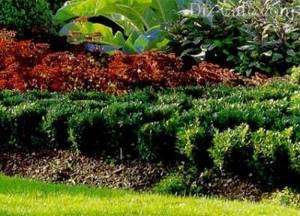
The dug-out border needs regular care: mulching with peat or crushed wood chips, leveling, cutting off overgrown turf roots with special scissors
A wicker border looks interesting and is great for areas arranged in a rustic style. To make it, ordinary willow rods are used, attached to posts driven into the ground. Weaving is a traditional ancient method that our ancestors used to create village fences - wattle fences.
A living border of low ornamental plants looks natural. In addition to herbs and flowers, low-growing shrubs are successfully used. The height of the fence can be any, but usually it does not exceed 40 cm, otherwise the fence will cover the flower garden.

Low-growing green perennials can be replaced with any bright flowers with small inflorescences, thus creating beautiful compositions in an unusual frame
How to make a living border: choosing plants, planting and pruning
A living fence can only be installed on a flat area where the flowerbed is not in danger of being washed out. Shrub plants with a short, spreading crown and a powerful root system are used. A good effect is achieved by planting boxwood, barberry and cotoneaster.
The seedlings are planted in the ditch at intervals of up to 20 cm, after which they are watered abundantly and constantly cultivated. As the bushes grow, the crowns intertwine, forming a continuous green wall. This combination of plants looks unusual, exotic and original. A living fence can decorate any area, even the most sophisticated one.
